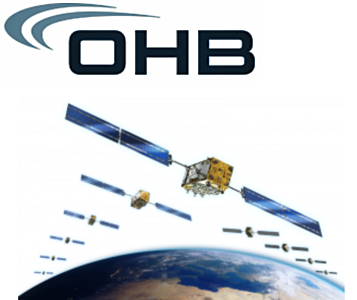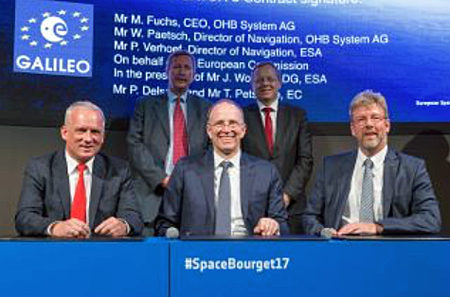
OHB System AG has just been awarded a contract to produce an additional eight navigation satellites for the Galileo program — the contract was signed during the Paris Air Show on June 22nd, 2017.
The contract is worth 324 million euros and this contract will increase the number of Galileo FOC satellites supplied by OHB to a total of 30, of which the first 14 are already in orbit. In its capacity as the producer of the satellite platform and the system manager, OHB is responsible for the satellite design and platform, integration and verification. In addition, it will be providing support during the launch preparations and in-orbit verification.
Successful partnerships to be continued

From left to right: W. Paetsch, Director Navigation of OHB System AG, P. Delsaux, Deputy Director-General of DG-Growth, European Commission, M. Fuchs, CEO of OHB System AG, J. Woerner, Director General ESA, P. Verhoef, Director of Navigation, ESA.
OHB will be able to rely on proven partnerships and subcontractors. As with the previous two contracts, the OHB UK partner Surrey Satellite Technology Ltd. (SSTL) has also contributed to this successful offer with the navigation payloads.
Shaping the future
Obviously, OHB wants to continue contributing to this beneficial project in the future. In Bremen, it is already working on designs for the next-generation Galileo satellites. In various studies for ESA, the engineers are exploring new materials and components and further services to be provided by the next generation. Needless to say, they are incorporating the experience gained from engineering and producing the previous navigation satellites. In this way, OHB can contribute proposals for the design of the next-generation satellites and offer the customer the benefits of the unique experience that it has gained from the successful first series.

Galileo FOC satellites undergoing testing at a cleanroom at the space center in Kourou, French-Guyana.
Photo is courtesy of ESA/CNES/Arianespace.
Management Board member Dr. Ingo Engeln, who is responsible for OHB System AG’s institutional space projects, is pleased to be able to continue production of the satellites. He stated that OHB's proven processes and structures, the seven assembly islands in Bremen, the corresponding facilities at the other integration and testing sites and, not least of all, the highly trained teams at participating companies provide an ideal basis for expanding the satellite constellation swiftly. This, together with the modular design of the satellites, will ensure that a pair of two satellites can be delivered within three months after the pair of satellites delivered before.
Paul Verhoef, ESA’s Director of Satellite Navigation, noted that this procurement from OHB will enable the completion of the Galileo constellation and will also ensure there are reserves both on obit and on ground. The 30 satellites added to the 4 IOV satellites now bring the necessary infrastructure robustness that is essential for the provision of Galileo services world-wide.
Marco Fuchs, CEO of OHB-System AG, stated he was very pleased that, after delivering 22 satellites under the first two contracts, OHB has now also retained the confidence of ESA and the European Commission in this third bid. The company is now able to make such a crucial contribution to this major European project that will be providing so many people around the world with valuable services.
Continuation of the proven satellite design
“Our modular satellite design is outstanding and has proven itself with superb results. A large part of the satellites that we have already assembled have demonstrated their full functional capability in space. For this reason, there will be no major changes to the design of the eight new satellites. At this stage, we are working on the basis of a first launch date in 2020,” said Dr. Wolfgang Paetsch, director of navigation at OHB System AG, who previously oversaw the development of the first and second satellite batch.

